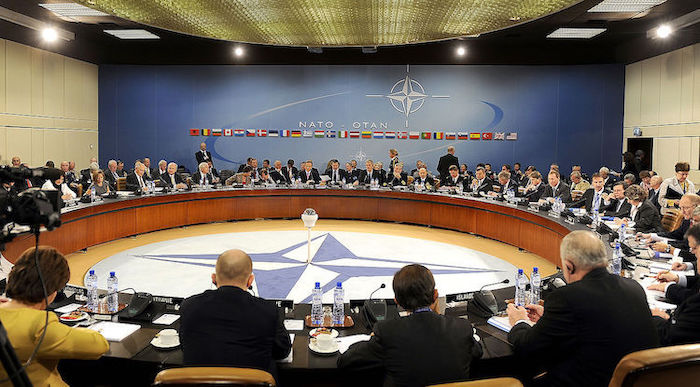By Robert Johnson
BRUSSELS (IDN) — “What we are currently experiencing is the brain death of NATO,” French President Emmanuel Macron declared in a blunt interview with The Economist in November 2019. Europe stands on “the edge of a precipice”, he said, and needs to start thinking of itself strategically as a geopolitical power; otherwise, we will “no longer be in control of our destiny.” [2021-05-12 | 03] CHINESE | JAPANESE | RUSSIAN
That was two years after Donald Trump took over as the U.S. President. But the apprehensive environment prompted NATO Secretary-General Jens Stoltenberg to appoint the “NATO Reflection Group,” co-led by former German Defence Minister Thomas de Maiziere and former US State Department official Wess Mitchell. This was also in view of the fact that NATO’s “Strategic Concept” outlining threats and capabilities to counter them has not been revised since 2010.
“Nuclear deterrence” has been at the core of NATO’s mutual security guarantee and collective defence since its inception in 1949. The very first NATO Strategic Concept the same year referenced the requirement to “ensure the ability to carry out strategic bombing promptly by all means possible with all types of weapons without exception.”
Both the 2010 Strategic Concept and the 2012 Deterrence and Defence Posture Review made clear that the current 30-nation North Atlantic Treaty Organization (NATO) seeks its security at the lowest possible level of forces and is fully committed to arms control, disarmament and non-proliferation.
The United States committed nuclear weapons to NATO in July 1953, with the first American theatre nuclear weapons arriving in Europe in September 1954. NATO’s nuclear sharing arrangements, which were already in place by the time negotiations for the Nuclear Non-Proliferation Treaty (NPT) began in the 1960s, were codified by the United States and the Soviet Union as a precursor for the final agreed NPT text.
The United Kingdom has also extended its nuclear forces, including its current single submarine-based system and Continuous At-Sea Deterrent, to the protection of NATO Allies for over 50 years.
Since the height of the Cold War, it has unilaterally reduced the size of its land-based nuclear weapons stockpile by over 90 per cent, reducing the number of nuclear weapons stationed in Europe and its reliance on nuclear weapons in strategy, stresses NATO.
Since progress on arms control and disarmament must take into account the prevailing international security environment, NATO argues, at the Warsaw Summit in 2016, NATO leaders recognised that conditions for achieving further disarmament were unfavourable given Russia’s aggressive actions and military build-up in recent years.
During the 2018 NATO Summit in Brussels, Heads of State and Government once again affirmed NATO’s long-standing commitment to nuclear deterrence, stating that “as long as nuclear weapons exist, NATO will remain a nuclear alliance.”
The NATO Reflection Group, set up by NATO Secretary General Stoltenberg, presented its final report on November 20, 2020. Titled “NATO 2030: United for a New Era“, the report focuses on the challenges of today and tomorrow. These, it says, are “Russia’s aggressive actions, the threat of terrorism, cyber-attacks, emerging and disruptive technologies, the security impact of climate change, and the rise of China.”
The report pleads for NATO adapting to meet the needs of “a more demanding strategic environment marked by the return of systemic rivalry, persistently aggressive Russia, the rise of China”, and the growing role of Emergent and Disruptive Technologies (EDTs), at the same time that it faces elevated transnational threats and risks.
The report wants NATO to continue the “dual-track approach of deterrence and dialogue” with Russia. In other words, the Alliance must respond to Russian “threats and hostile actions in a politically united, determined, and coherent way, without a return to ‘business as usual’ barring alterations in Russia’s aggressive behaviour and its return to full compliance with international law”.
At the same time, NATO would remain open to discussing peaceful co-existence and to reacting positively to constructive changes in Russia’s posture and attitude. Besides, NATO’s dual-track strategy will result in raising “the costs for Russian aggression”— even of “hybrid forms of Russian aggression”, while at the same time supporting increased political outreach to negotiate arms control and risk reduction measures.
Also, NATO needs to devote much more time, political resources, and action to the security challenges posed by China—based on an assessment of its national capabilities, economic heft, and the stated ideological goals of its leaders.
The report adds: NATO should develop a political strategy for approaching a world in which China will be of growing importance through to 2030. The Alliance should infuse the China challenge throughout existing structures and consider establishing a consultative body to discuss all aspects of Allies’ security interests vis-à-vis China.
It must expand efforts to assess the implications of China’s technological development and monitor and defend against any Chinese activities that could impact collective defence, military readiness or resilience in the Supreme Allied Commander Europe’s (SACEUR) Area of Responsibility.
The NATO Summit in Brussels on June 14, 2021, at the Alliance HQ in Brussels, Belgium will be “a unique opportunity to reinforce NATO as the enduring embodiment of the bond between Europe and North America,” says a NATO press release. [IDN-InDepthNews — 12 May 2021]
Photo: US Defense Secretary Robert M. Gates and other members of NATO Ministers of Defense and of Foreign Affairs meet at NATO headquarters in Brussels, Belgium, Oct. 14, 2010.




